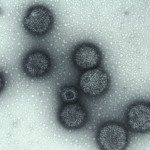Lien vers Pubmed [PMID] – 33238280
Lien DOI – 10.1159/000511575
Intervirology 2020 ; 63(1-6): 17-32
Transmission of many viruses occurs by direct transmission during a close contact between two hosts, or by an indirect transmission through the environment. Several and often interconnected factors, both abiotic and biotic, determine the persistence of these viruses released in the environment, which can last from a few seconds to several years. Moreover, viruses in the environment are able to travel short to very long distances, especially in the air or in water.Although well described now, the role of these environments as intermediaries or as reservoirs in virus transmission has been extensively studied and debated in the last century. The majority of these discoveries, such as the pioneer work on bacteria transmission, the progressive discoveries of viruses, as well as the persistence of the influenza virus in the air varying along with droplet sizes, or the role of water in the transmission of poliovirus, have contributed to the improvement of public health. Recent outbreaks of human coronavirus, influenza virus, and Ebola virus have also demonstrated the contemporaneity of these research studies and the need to study virus persistence in the environment. Key Messages: In this review, we discuss historical discoveries that contributed to describe biotic and abiotic factors determining viral persistence in the environment.

